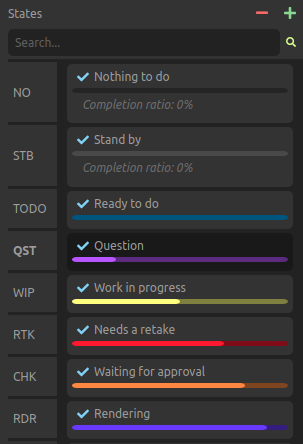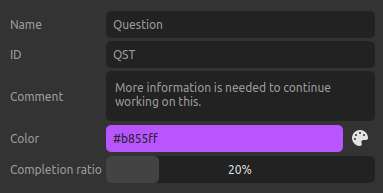 State management
State management

This panel is used to list and manage all the states used by Ramses for production tracking. The states are shared by all projects.
The list of available states can be completely customized.
Read the section about Production tracking for more details about states and status.
List

The list on the left lists all the states, and you can use the Search field to filter them by name or ID.
When changing the size of the rows in the list, more details about each state can be displayed.
Use the button to create a new state. The
button removes the selected states from Ramses1.
You can use the [Shift + A] shortcut key to quickly add new states.
You can use the [DEL] or [Shift + X] shortcut key to quickly remove selected states.
You can scroll all lists using [Middle click] as well as the [Mouse wheel].
A few states can’t be removed as they are needed by Ramses automations (but they can still be customized, only their ID can’t change): NO, STB, TODO, WIP, OK.
Edition

- Name is the state’s display name.
- ID is the unique identifier which is used in the files and folders (see the Ramses Tree section and the Ramses naming convetions). It is also used in the user interface when there is too little room to use the name.
- Comment can be any text associated to the state. You can use it to describe the state and explain what it means. This comment has nothing to do with the actual production status of shots and assets, it is linked to the state itself and just describes it.
- The color is used to display the states in the user interface and easily differenciate them in lists.
- Input a custom hexadecimal color code in the field.
- Click the
button to use a nice color selector.
- The completion ratio is used to automatically set a default value to the completion of the tasks when their state changes. This task completion ratio can then be adjusted by the user for each individual task.
▹ More details about Production tracking and the states.
-
The data is not actually deleted from the server nor the local data, but just flagged as removed. A server administrator can still restore the data at any time, but there is no way (yet) to do that from the user interface of the application. ↩